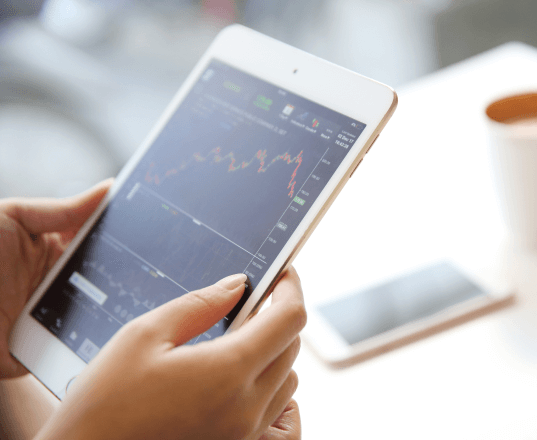CFDs
With Onlinecfdsim you can choose from a variety of different trading products including currencies, stocks, commodities and shares.
CFDs Trading
Considering trading CFDs? These versatile
derivatives offer good potential for higher
returns — but with this potential comes higher
risk. High risk may result from the changes in
the asset’s price to how much leverage applies
to the position. A higher leverage leads to
higher risk levels. There are some fundamental
aspects you should be aware of before you start
trading CFDs.

What are CFDs?
A CFD (Contract for
Difference) is an agreement to exchange the difference in the
value of an asset from the time the contract is opened until the
time at which it is closed.
With a CFD, traders never actually own the asset or instrument, but they can still benefit if the market moves in their favour. This is because a CFD is a derivative product, which has a value based on an underlying asset.
Trading CFDs is risky, and it is highly recommended to gain knowledge before you start trading. In case you do not have any experience, trading CFDs may not be appropriate for you. Before you start trading with us, it is recommended that you complete the appropriateness questionnaire.
How does it work?
As derivative products,
CFDs allow traders to speculate on price changes without
actually owning any of the underlying assets involved. They can
be used to trade a variety of financial markets like shares,
forex, commodities, indices or bonds. CFDs are traded in
contracts, which means that you take out a certain number of
contracts, and each is equal to a base amount of the underlying
asset. With Onlinecfdsim you can trade CFDs on a wide range of
markets, including shares, indices, commodities, foreign
exchange and many more. Trading a share CFD, for example, is in
many ways similar to traditional share trading, but with added
advantages and risks that are typical of trading on the stock
market.
Please make sure you read every product description (currencies, indices, etc.), as well as the given examples, to better understand the risk that trading with CFDs involves. The risk may result from changes in the asset’s price or how much leverage is applicable in the open position.
Five considerations for CFD trading
These
are some of the most important rules to consider when trading
CFDs related to risk management and careful planning. While
there are various trading methods that can be developed to help
you work out how and why you will place a trade, these
considerations are fundamental.
1) Trading CFDs can be risky – Invest only funds you can
afford to lose.
2) Pay close attention to managing your
existing trades — don’t just look for new
trades.
3) Try to gain as much knowledge as possible before
you start. Without knowledge, trading CFDs can be very risky.
Please note that knowledge is not a guarantee of success.
4)
Be aware of the risk that you’re exposed to — both
on individual positions and in your portfolio as a whole.
5)
Understanding how to use the PROfit platform is highly important
before you begin your trading with Onlinecfdsim.
How to trade CFDs
When trading shares, the
investor actually has an ownership in the company. If the prices
of the shares increases, the investor’s profit is actually
the difference between the buying price and the selling price.
In case the share price drops, the loss is calculated as the
difference between the buying and the selling price. This
implies to any share the investor owns.
When the investor trades ounces of gold, his possible profits will come from the difference between the buying price and the selling price for every ounce of gold he had purchased. In case the prices fall, investor’s loss is again the difference between the buying and the selling price for each gold ounce he has.
It is important to note that, when trading CFDs, the investor the
doesn’t own the actual share or gold ounce, but only the
contract on the price value of the financial instrument.
Examples for trading CFDs
Let’s suppose that the investor thinks that gold price will
increase so he buys 10 ounces of gold with a current buying
price at the gold shop is $1,200 per ounce. He would have to pay
$1,200 per ounce for 10 ounces of gold:
10oz X 1200 = $12000
Let’s say that GOLD price reaches $1,250, then the investor can
sell the ounces and collect the profits:
10oz X 1250 = $12500 hence profit is 12500 – 12000= $500
However, let’s say that the prices fall by $50 and go to $1,150
per ounce and the investor sells the 10 ounces, then his loss
will be $500:
10oz X 1150 = 11500 hence loss is 11500 – 12000= -$500.
CFDs with an expiry date
As CFDs are traded
on the price value of other financial instruments and these
instruments have an expiry date, the CFDs will also have the
same expiry date.
See examples below:
CL (Crude Oil) is being traded as a future contract in the
NYMEX, with an expiry date signifying that the contract will be
closed at the end of the indicated date. In this case the CFD
will also have the same expiry date and investors will not be
able to trade it after this date. As any open positions will be
automatically closed, the investor will have to get into a new
CFD contract that follows the new future contract with a new
expiry date, in case he wants to keep the Crude Oil CFD
contract.

What is Margin?
As the above examples show, when trading CFDs
the investor owns a contract, that ‘’binds’’ him
to pay for any difference in the price with a
loss and the other party commits to pay him the
earning, it is not necessary for the investor to
actually own the gold. Because of that, there is
no real purchase of gold, but only a contract,
so the investor will have to provide the margin
to secure the potential losses that he might
suffer.
Example:
The investor buys 5 ounces of Gold via CFDs at a price of $1,200
per ounce, amounting to a total trade value/exposure of $6,000
(= 5 ounces x $1,200). The minimum margin for Gold trading with
Onlinecfdsim is 5%. Therefore, the investor should have a minimum
of $300 ($6,000 x 5% = $300) available margin in his trading
account, in order to secure any potential loss for the specific
trade. Using a small amount of funds in order to have a larger
exposure is referred to as “Leverage”. The investor leverages
his $300, to have a higher trade for the value of $6,000. The
investor is liable for the leveraged amount in all aspects,
whether it be profit, loss, overnight fees, etc.

What is Leverage?
A leverage of 1:30 means that the investor can
have a maximum trade value/exposure of 30 times
his account equity, e.g. an investor who
deposits $1,000 to his trading account will have
the maximum ability to trade with $30,000. The
investor will be fully liable for the trade
outcome, whether it be profit, loss, fees,
spread value, etc.
Example:
An investor who makes a deposit on his trading account and
wishes to buy 10 ounces of Gold via CFDs at market price, is
allowed to trade in Gold with a leverage of 1:20. The investor
opens the trading box available on the trading platform and
creates the requested contract details of 100 ounces of Gold.
The trading platform calculates the minimum margin to open the
trading position
i.e. trade value = 10 ounces x buying price $1,200 = $12,000
(Total Exposure).
The margin with 1:20 leverage (5%) = total exposure $12,000/20 =
$600. This means that the investor has $1,000, therefore he has
more than the minimum required and is able to open a position.
What is Liquidation?
In a highly unstable and fast moving market it is possible for
an investor to lose his capital, which in online trading is also
known as liquidation.
For Instance:
An investor purchases 100 ounces of Gold via CFDs and the price
per ounce is $1,200, amounting to an exposure of $120,000. If
the Gold price drops by 0.85% within a period of 30 minutes,
this fast moving change will put the investor’s equity at risk
and he will incure a loss of $1,020 ($120,000 x 0.85%. The
investor will lose all his capital at once and without being
able to respond to the loss.
When the client is at risk of liquidation, he will receive a
relevant popup warning on his trading platform.
However, when the investor is not logged in to his platform, he
needs to be aware that there is risk of liquidation.
What is Synthetic Derivatives Split/Reverse Split Price
Adjustment
A price adjustment on synthetic derivatives takes place when the
value of the Synthetic Derivative reached a pre-defined level of
its original value in order to correct its price. For example,
for an instrument with a “Synthetic Derivative value at
inception” 1000:
- If the leveraged symbols value reaches a value of 100, a reverse split event is implemented and in the following weekend the price will reset to 1,000.
- If the leveraged symbols value reaches a value of 10,000, a split event is implemented and in the following weekend the price will reset to 1,000.
- In order to avoid a difference in your position’s value due to the Reverse split or split of the Synthetic Derivative, a different open price may be implemented by the system to reflect the market fluctuation between the old and new price. In such a case your account equity will not be affected. Please note that any existing Stop Loss or Take Profit, will not be transferred to the new related positions.